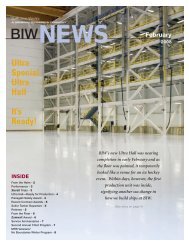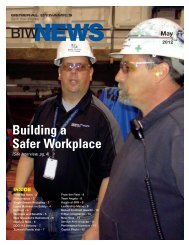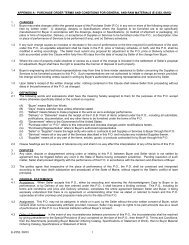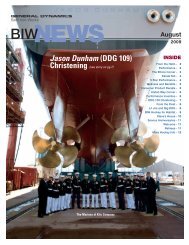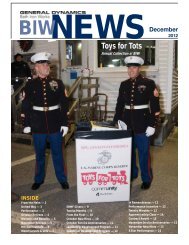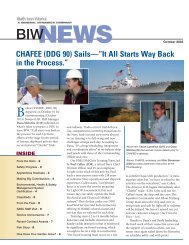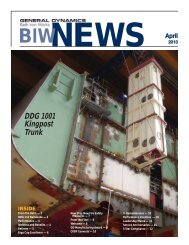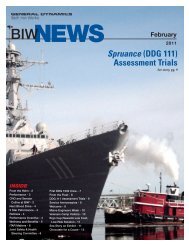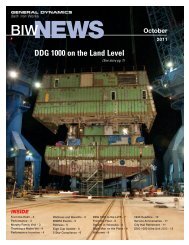APR - Bath Iron Works
APR - Bath Iron Works
APR - Bath Iron Works
You also want an ePaper? Increase the reach of your titles
YUMPU automatically turns print PDFs into web optimized ePapers that Google loves.
The BIW Machine ShopOn April 18, BIW began the demolitionand removal of the old Machine Shop,which had become the oldest buildingin the shipyard. Andy Toppan (D40)recaps some of the highlights of thishistoric building and reminds us thatthen, as now, changes in this area led toimprovements in how ships were built atBIW.BIW in the 1890’s was a small andrelatively simple shipyard, tightlyclustered around the areabetween the ways and the MachineShop. Many of the yard’s small buildingsdated to the early 1880’s and theprior owner of the facility, Goss <strong>Iron</strong><strong>Works</strong>. After a huge fire destroyedmost of the shipyard in 1894, BIWembarked on a series of facilitiesupgrades. More than just replacingthe ruined buildings, over the courseof five years, these projects nearlydoubled the size of the shipyard.The final step of this modernizationwas replacement of the old MachineShop building which dated from 1882.The task of designing the new facilityfell to John S. Hyde, son of founderand President General Hyde. To meetthe growing company’s needs, Hydedesigned a shop that was more thandouble the size of its predecessor andremained the largest building at BIWinto the 1950’s. To keep productionmoving, the new shop was literallybuilt around the old building whichwas then demolished.John Hyde was an advocate of newtechnology, so the shop included anumber of advancements includingelectric motors for the machines inplace of earlier steam engines and thenow-familiar use of compressed airtools. The shop also featured dualoverhead cranes, one above the other,and space at the east end for constructionof small-to-midsize vessels inside.BIW was already building small vesselsindoors—the adjacent Plate Shophad recently been enlarged to providespace for three torpedo boats—butthe Machine Shop provided a muchlarger space.The new shops gave BIW athoroughly modern facility and1929 view of the BIW shipyard from the Carlton Bridge with the Machine Shop the largest building on the waterfront.The yachts Paragon (Hull 122) and Althea (Hull 132) were both built in the Machine Shop and delivered in 1930.positioned the yard for success in the comingyears. Through a series of contractsincluding cruisers, a battleship, and manydestroyers, BIW built a reputation forexcellence and innovation in shipbuilding.Among the innovations were the first turbine-drivenwarship (the cruiser Chester),the first turbine-driven destroyer (Flusser),and the first destroyer with reduction gears(Wadsworth). The engines for each of theseships, and all ships of the era, were assembledand tested in the Machine Shop beforeinstallation on the ways.The years around World War I broughta small surge in work to BIW and an expansionof the Machine Shop. The buildingwas extended to the west by several bays,gaining the familiar “1917” marker on thewest wall. Unfortunately, the amount ofwork available in the post-war years couldnot keep the shipyard going and productionceased in 1925. The following year, theMachine Shop marked the close of an eraas auctioneers and bidders gathered inthe shop to sell off the yard’s tools andmachinery.6 | April 2012 | BIW NEWS



